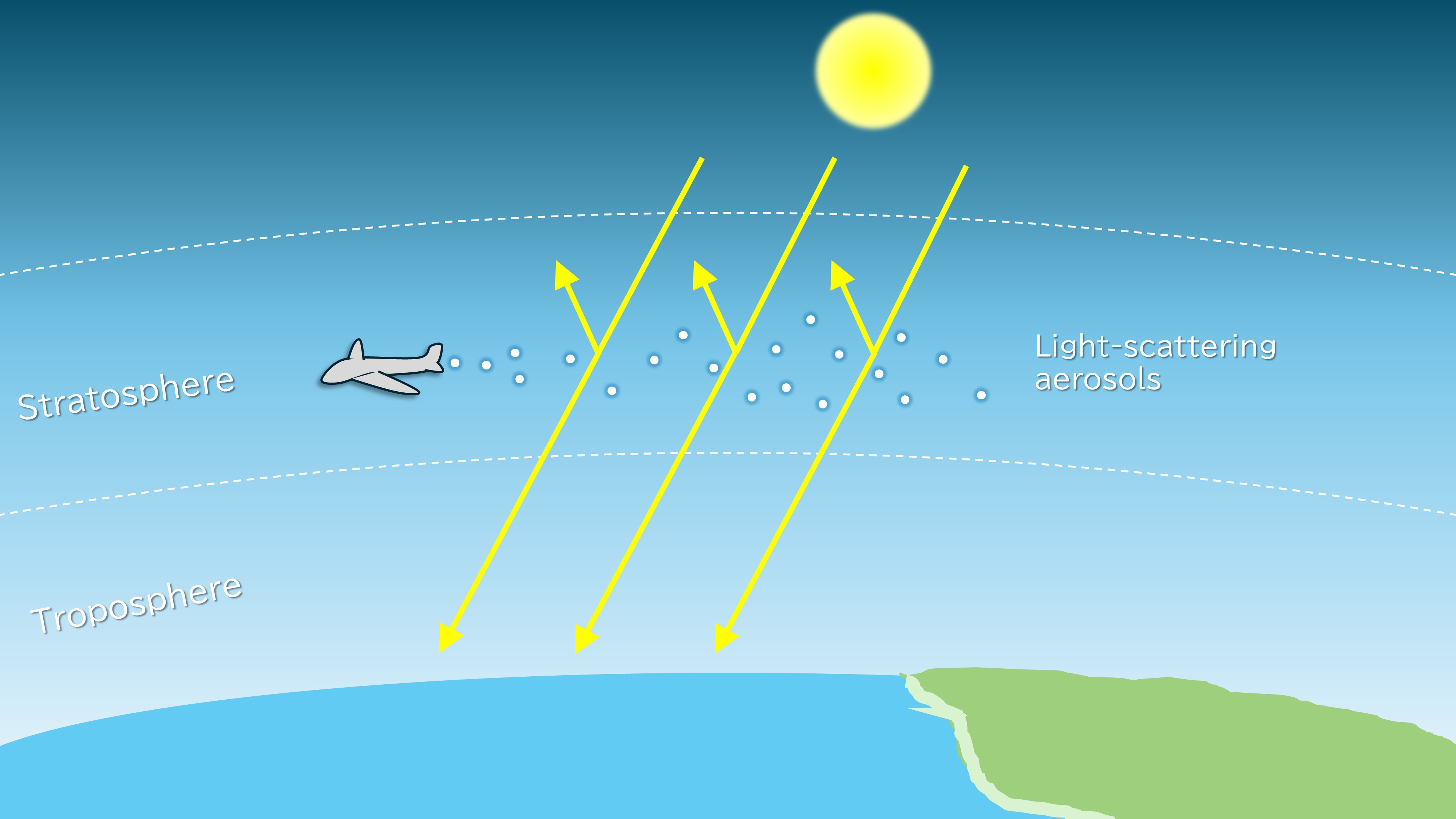Reducing greenhouse gas emissions is essential for mitigating global warming. However, practical difficulties of reducing global emission in a required timescale increase risks of severe impacts on human society and global ecosystems. Consequently, the climate science community has recently intensified researches on climate intervention as a potential measure to buy time until sufficient emission reductions and warming mitigation are achieved.
Among geoengineering approaches for controlling the climate1, climate intervention refers to methods involving atmospheric physical and chemical processes. Current most focused methods include Marine Cloud Brightening (MCB)2 and Stratospheric Aerosol Injection (SAI)3 (Fig. 1). SAI is currently considered a relatively robust and cost-effective approach to counteracting greenhouse gas radiative forcing4,5. SAI artificially replicates the temporary cooling effects of volcanic aerosols on the climate; the 1991 Mount Pinatubo eruption demonstrated this mechanism, where stratospheric sulfate aerosols increased solar reflection, reducing global mean temperature by approximately 0.5°C6. Key scientific and technical challenges in SAI research include:
-
Understanding the baseline state: Understanding composition, concentration, size distribution, formation/removal processes, and transport mechanisms in the present background stratosphere through observations and models7.
-
Optimizing particle properties: Selecting cost-effective, non-harmful candidate materials and designing practical methods to control the aerosol size distribution for efficient light scattering and slow gravitational settling8.
-
Mitigating the side effects: Assessing the potential side effects of injected aerosol particles on stratospheric chemistry (e.g., ozone layer) as well as stratospheric dynamics 9,10.
Multiscale research addressing these challenges spans from aerosol physicochemical processes to large-scale circulation. Governance and global political consensus will be the most challenging issues in actual deployment of climate intervention11. Global warming-induced increases in wildfires might change baseline stratospheric aerosol levels through increased aerosol inputs by pyrocumulus convection12. Amid global anthropogenic aerosol reductions, new perspectives in aerosol-climate research are becoming increasingly important for predicting the effects and side effects of climate intervention.
Fig. 1. Concept of stratospheric aerosol injection for cooling climate
References
-
National Research Council, Division on Earth, Life Studies, Ocean Studies Board, Board on Atmospheric Sciences, Committee on Geoengineering Climate, Climate Intervention: Reflecting Sunlight to Cool Earth, National Academies Press, 2015. https://doi.org/10.17226/18988.
-
Feingold, G., Ghate, V. P., Russell, L. M., Blossey, P., Cantrell, W., Christensen, M. W., et al., Physical science research needed to evaluate the viability and risks of marine cloud brightening, Sci. Adv., 10(12), eadi8594, 2024. https://doi.org/10.1126/sciadv.adi8594.
-
Huynh, H. N., and McNeill, V. F., The potential environmental and climate impacts of stratospheric aerosol injection: a review, Environ. Sci.: Atmospheres, 2024. https://doi.org/10.1039/D3EA00134B.
-
Shepherd, J. G., Geoengineering the Climate: Science, Governance and Uncertainty, Royal Society, 2009. https://royalsociety.org/news-resources/publications/2009/geoengineering-climate/.
-
Parson, E. A., and Keith, D. W., Solar geoengineering: History, methods, governance, prospects, Annu. Rev. Environ. Resour., 49, 2024. https://doi.org/10.1146/annurev-environ-112321-081911.
-
Soden, B. J., Wetherald, R. T., Stenchikov, G. L., and Robock, A., Global cooling after the eruption of Mount Pinatubo: A test of climate feedback by water vapor, Science, 296(5568), 727–730, 2002. https://doi.org/10.1126/science.296.5568.727.
-
Kremser, S., Thomason, L. W., von Hobe, M., Hermann, M., Deshler, T., Timmreck, C., et al., Stratospheric aerosol—Observations, processes, and impact on climate, Rev. Geophys., 54(2), 278–335, 2016. https://doi.org/10.1002/2015RG000511.
-
Vattioni, S., Käslin, S. K., Dykema, J. A., Beiping, L., Sukhodolov, T., Sedlacek, J., et al., Microphysical interactions determine the effectiveness of solar radiation modification via stratospheric solid particle injection, Geophys. Res. Lett., 51(19), e2024GL110575, 2024. https://doi.org/10.1029/2024GL110575.
-
Heckendorn, P., Weisenstein, D., Fueglistaler, S., Luo, B. P., Rozanov, E., Schraner, M., et al., The impact of geoengineering aerosols on stratospheric temperature and ozone, Environ. Res. Lett., 4(4), 045108, 2009. https://doi.org/10.1088/1748-9326/4/4/045108.
-
Vattioni, S., Weber, R., Feinberg, A., Stenke, A., Dykema, J. A., Luo, B., et al., A fully coupled solid-particle microphysics scheme for stratospheric aerosol injections within the aerosol–chemistry–climate model SOCOL-AERv2, Geosci. Model Dev., 17(21), 7767–7793, 2024. https://doi.org/10.5194/gmd-17-7767-2024.
-
Baum, C. M., Fritz, L., Low, S., and Sovacool, B. K., Public perceptions and support of climate intervention technologies across the Global North and Global South, Nat. Commun., 15(1), 2060, 2024. https://doi.org/10.1038/s41467-024-46341-5.
-
Katich, J. M., Apel, E. C., Bourgeois, I., Brock, C. A., Bui, T. P., Campuzano-Jost, P., et al., Pyrocumulonimbus affect average stratospheric aerosol composition, Science, 379(6634), 815–820, 2023. https://doi.org/10.1126/science.add3101.
